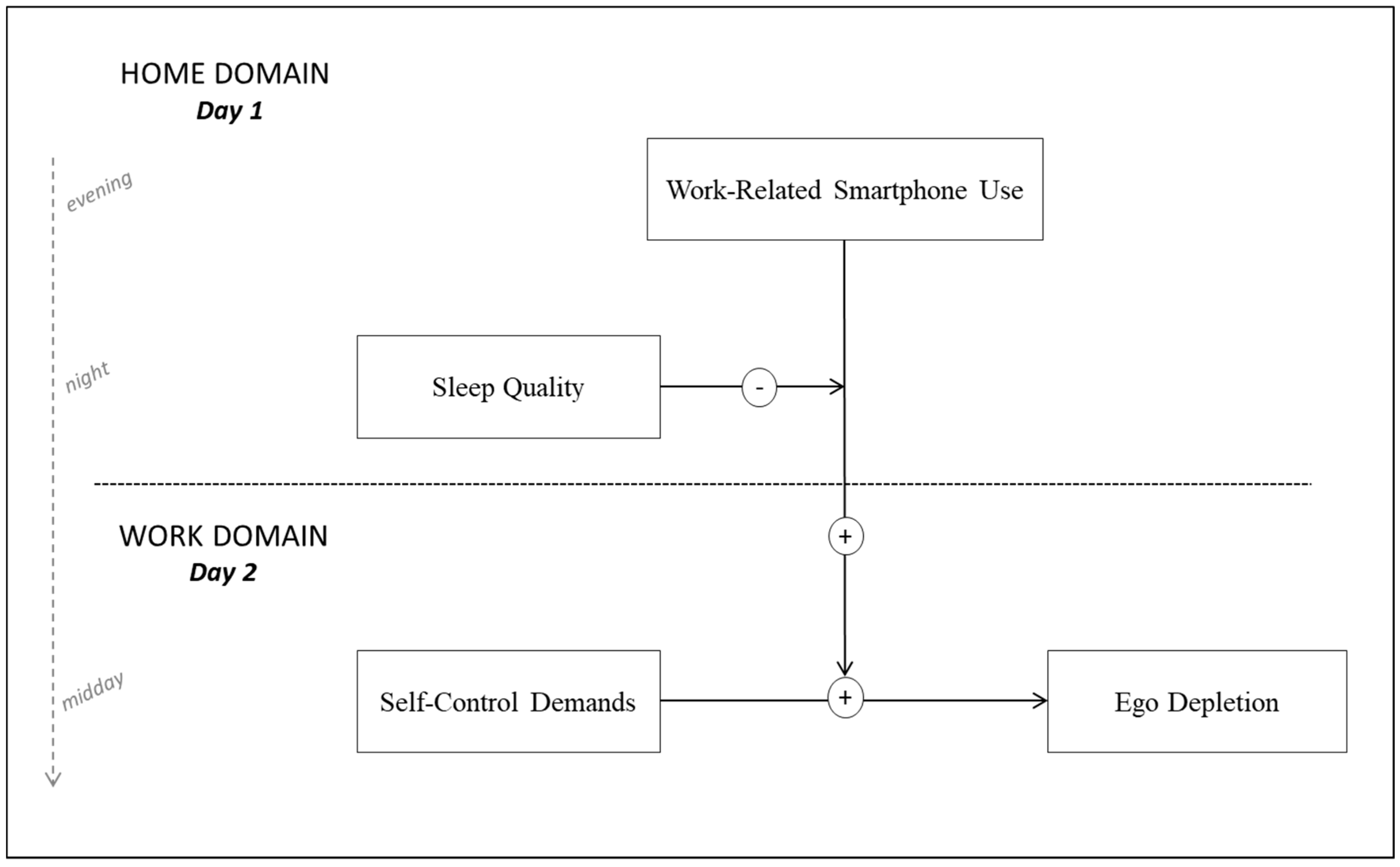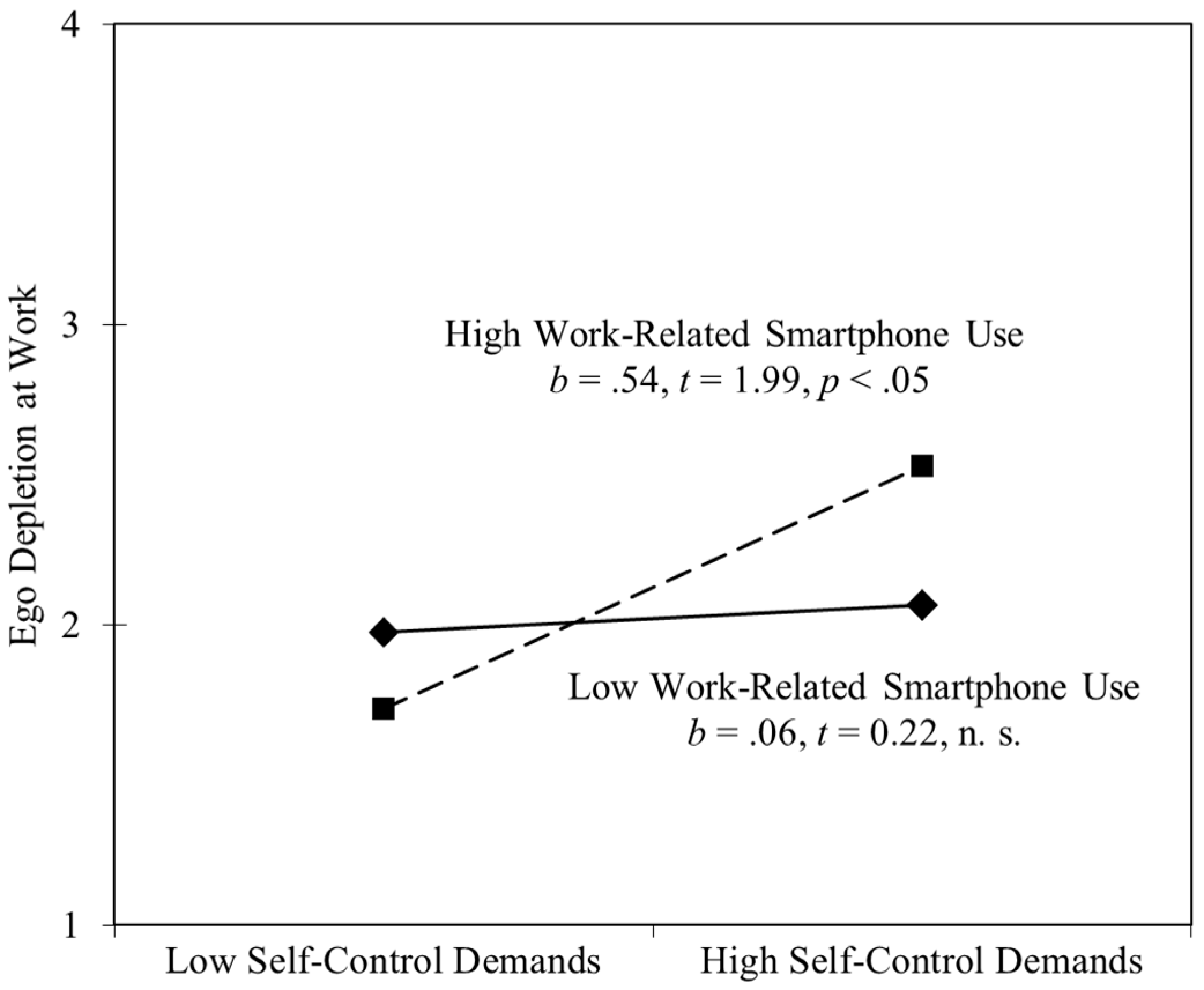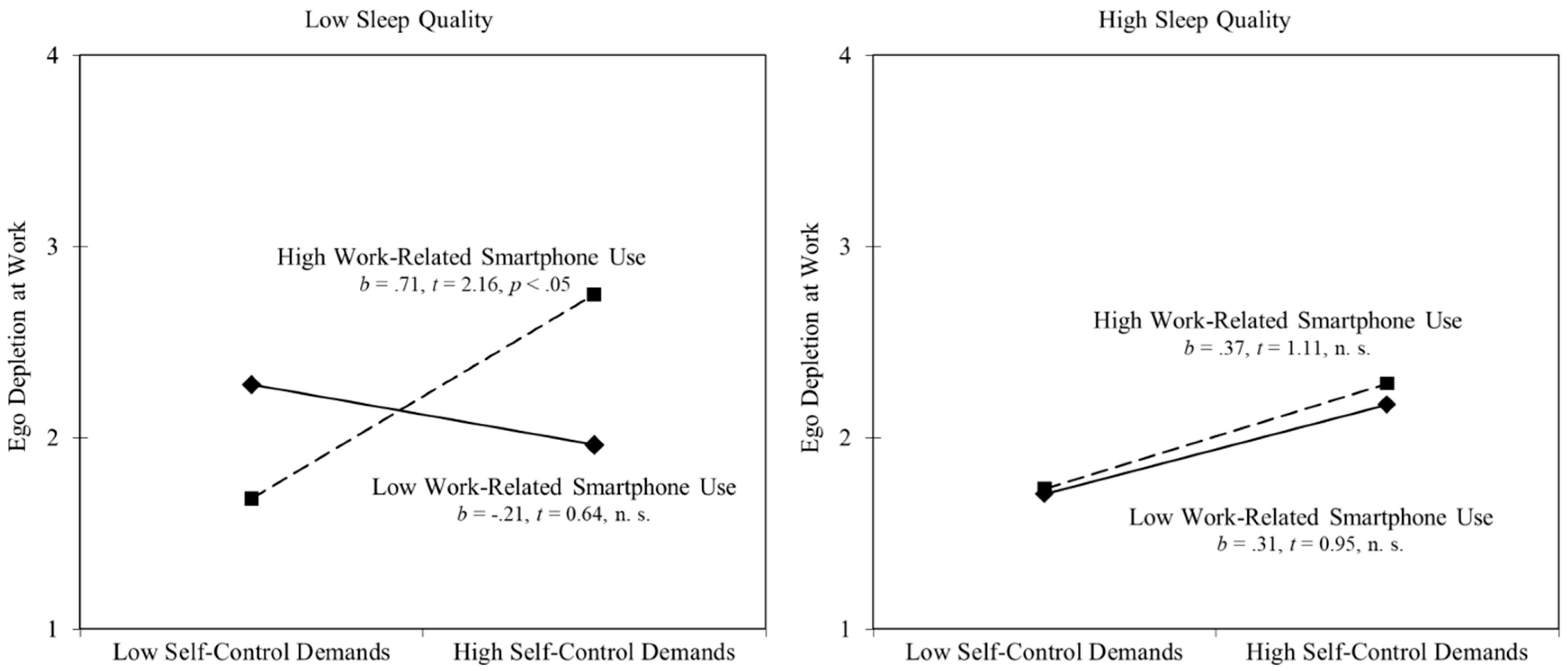Protect Your Sleep When Work is Calling: How Work-Related Smartphone Use During Non-Work Time and Sleep Quality Impact Next-Day Self-Control Processes at Work
Abstract
1. Introduction
1.1. Self-Control Demands: A Source of Stress at Work
1.2. Joint Effects of Work-Related Smartphone Use at Home and Self-Control Demands at Work on Ego Depletion
1.3. The Protective Function of Sleep Quality: Recovering the Limited Self-Control Resource
2. Materials and Methods
2.1. Participants and Procedure
2.2. Measures and Control Variables
2.3. Construct Validity
2.4. Strategy of Analyses
3. Results
3.1. Testing the Two-Way Interaction between Work-Related Smartphone Use and Self-Control Demands
3.2. Testing the Three-Way Interaction between Work-Related Smartphone Use, Self-Control Demands, and Sleep Quality
4. Discussion
4.1. Summary of the Results
4.2. Theoretical Implications
4.3. Practical Implications
4.4. Limitations and Suggestions for Future Research
5. Conclusions
Author Contributions
Acknowledgements
Conflicts of Interest
References
- Cascio, W.F. Changes in Workers, Work, and Organizations. In Handbook of Psychology: Industrial and Organizational Psychology; Bormann, C., Ilgen, D.R., Klimoski, R.J., Eds.; John Wiley & Sons Inc.: Hoboken, NJ, USA, 2003; pp. 401–422. [Google Scholar]
- Schmidt, K.-H.; Diestel, S. Self-Control Demands: From basic research to job-related applications. J. Pers. Psychol. 2015, 14, 49–60. [Google Scholar] [CrossRef]
- Muraven, M.; Baumeister, R.F. Self-Regulation and Depletion of Limited Resources: Does Self-Control Resemble a Muscle? Psychol. Bull. 2000, 126, 247–259. [Google Scholar] [CrossRef] [PubMed]
- Bertrams, A.; Unger, A.; Dickhäuser, O. Momentan verfügbare Selbstkontrollkraft—Vorstellung eines Messinstruments und erste Befunde aus pädagogisch-psychologischen Kontexten. Z. Pädagog. Psychol. 2011, 25, 185–196. [Google Scholar] [CrossRef]
- Rivkin, W.; Diestel, S.; Schmidt, K.-H. Affective commitment as a moderator of the adverse relationships between day-specific self-control demands and psychological well-being. J. Vocat. Behav. 2015, 88, 185–194. [Google Scholar] [CrossRef]
- Lanaj, K.; Johnson, R.E.; Barnes, C.M. Beginning the workday yet already depleted? Consequences of late-night smartphone use and sleep. Organ. Behav. Hum. Decis. Process. 2014, 124, 11–23. [Google Scholar] [CrossRef]
- Edwards, J.R.; Rothbard, N.P. Mechanisms Linking Work and Family: Clarifying the Relationship Between Work and Family Constructs. Acad. Manag. Rev. 2000, 25, 178–199. [Google Scholar] [CrossRef]
- Schmidt, K.-H. The relation of goal incongruence and self-control demands to indicators of job strain among elderly care nursing staff: A cross-sectional survey study combined with longitudinally assessed absence measures. Int. J. Nurs. Stud. 2010, 47, 855–863. [Google Scholar] [CrossRef] [PubMed]
- Diestel, S.; Schmidt, K.-H. Costs of simultaneous coping with emotional dissonance and self-control demands at work: Results from two German samples. J. Appl. Psychol. 2011, 96, 643–653. [Google Scholar] [CrossRef] [PubMed]
- Sonnentag, S. Recovery, work engagement, and proactive behavior: A new look at the interface between nonwork and work. J. Appl. Psychol. 2003, 88, 518–528. [Google Scholar] [CrossRef] [PubMed]
- Derks, D.; van Mierlo, H.; Schmitz, E.B. A diary study on work-related smartphone use, psychological detachment and exhaustion: Examining the role of the perceived segmentation norm. J. Occup. Health Psychol. 2014, 19, 74–84. [Google Scholar] [CrossRef] [PubMed]
- Derks, D.; ten Brummelhuis, L.L.; Zecic, D.; Bakker, A.B. Switching on and off: Does smartphone use obstruct the possibility to engage in recovery activities? Eur. J. Work Organ. Psychol. 2014, 23, 80–90. [Google Scholar] [CrossRef]
- Derks, D.; Bakker, A.B.; Peters, P.; van Wingerden, P. Work-related smartphone use, work–family conflict and family role performance: The role of segmentation preference. Hum. Relat. 2016, 69, 1045–1068. [Google Scholar] [CrossRef]
- Xanthopoulou, D.; Bakker, A.B.; Ilies, R. Everyday working life: Explaining within-person fluctuations in employee well-being. Hum. Relat. 2012, 65, 1051–1069. [Google Scholar] [CrossRef]
- Schmidt, K.-H.; Neubach, B. Self-control demands: A source of stress at work. Int. J. Stress Manag. 2007, 14, 398–416. [Google Scholar] [CrossRef]
- Sonnentag, S.; Pundt, A.; Venz, L. Distal and proximal predictors of snacking at work: A daily-survey study. J. Appl. Psychol. 2017, 102, 151–162. [Google Scholar] [CrossRef] [PubMed]
- Rivkin, W.; Diestel, S.; Schmidt, K.-H. Which daily experiences can foster well-being at work? A diary study on the interplay between flow experiences, affective commitment, and self-control demands. J. Occup. Health Psychol. 2018, 23, 99–111. [Google Scholar] [CrossRef] [PubMed]
- Clarkson, J.J.; Hirt, E.R.; Jia, L.; Alexander, M.B. When perception is more than reality: The effects of perceived versus actual resource depletion on self-regulatory behavior. J. Pers. Soc. Psychol. 2010, 98, 29–46. [Google Scholar] [CrossRef] [PubMed]
- Derks, D.; Bakker, A.B. Smartphone Use, Work-Home Interference, and Burnout: A Diary Study on the Role of Recovery. Appl. Psychol. 2014, 63, 411–440. [Google Scholar] [CrossRef]
- Gajendran, R.S.; Harrison, D.A. The good, the bad, and the unknown about telecommuting: Meta-analysis of psychological mediators and individual consequences. J. Appl. Psychol. 2007, 92, 1524–1541. [Google Scholar] [CrossRef] [PubMed]
- Ohly, S.; Latour, A. Work-Related Smartphone Use and Well-Being in the Evening. J. Pers. Psychol. 2014, 13, 174–183. [Google Scholar] [CrossRef]
- Kehr, H.M. Integrating Implicit Motives, Explicit Motives, and Perceived Abilities: The Compensatory Model of Work Motivation and Volition. Acad. Manag. Rev. 2004, 29, 479–499. [Google Scholar] [CrossRef]
- Abraham, R. Emotional Dissonance in Organizations: Antecedents, Consequences, and Moderators. Genet. Soc. Gen. Psychol. Monogr. 1998, 124, 229–246. [Google Scholar] [PubMed]
- Barnes, C.M. Working in our sleep. Organ. Psychol. Rev. 2012, 2, 234–257. [Google Scholar] [CrossRef]
- Baumeister, R.F.; Bratslavsky, E.; Muraven, M.; Tice, D.M. Ego depletion: Is the active self a limited resource? J. Pers. Soc. Psychol. 1998, 74, 1252–1265. [Google Scholar] [CrossRef] [PubMed]
- Barber, L.K.; Munz, D.C.; Bagsby, P.G.; Powell, E.D. Sleep consistency and sufficiency: are both necessary for less psychological strain? Stress Health 2009, 26, 186–193. [Google Scholar] [CrossRef]
- Meijman, T.F.; Mulder, G. Psychological aspects of workload. In Handbook of Work and Organizational Psychology; Drenth, P.J.D., Thierry, H., Wolff, C.J.D., Eds.; Psychology Press: Hove, UK, 1998; pp. 5–33. ISBN 0863775225. [Google Scholar]
- Hofmann, W.; Schmeichel, B.J.; Baddeley, A.D. Executive functions and self-regulation. Trends Cogn. Sci. 2012, 16, 174–180. [Google Scholar] [CrossRef] [PubMed]
- Tabibnia, G.; Monterosso, J.R.; Baicy, K.; Aron, A.R.; Poldrack, R.A.; Chakrapani, S.; Lee, B.; London, E.D. Different Forms of Self-Control Share a Neurocognitive Substrate. J. Neurosci. 2011, 31, 4805–4810. [Google Scholar] [CrossRef] [PubMed]
- Diestel, S.; Rivkin, W.; Schmidt, K.-H. Sleep quality and self-control capacity as protective resources in the daily emotional labor process: Results from two diary studies. J. Appl. Psychol. 2015, 100, 809–827. [Google Scholar] [CrossRef] [PubMed]
- Liu, Y.; Song, Y.; Koopmann, J.; Wang, M.; Chang, C.-H. (Daisy); Shi, J. Eating your feelings? Testing a model of employees’ work-related stressors, sleep quality, and unhealthy eating. J. Appl. Psychol. 2017, 102, 1237–1258. [Google Scholar] [CrossRef] [PubMed]
- Kühnel, J.; Bledow, R.; Feuerhahn, N. When do you procrastinate? Sleep quality and social sleep lag jointly predict self-regulatory failure at work. J. Organ. Behav. 2016, 37, 983–1002. [Google Scholar] [CrossRef]
- Kühnel, J.; Zacher, H.; de Bloom, J.; Bledow, R. Take a break! Benefits of sleep and short breaks for daily work engagement. Eur. J. Work Organ. Psychol. 2017, 26, 481–491. [Google Scholar] [CrossRef]
- Buysse, D.J.; Reynolds, C.F.; Monk, T.H.; Berman, S.R.; Kupfer, D.J. The Pittsburgh sleep quality index: A new instrument for psychiatric practice and research. Psychiatry Res. 1989, 28, 193–213. [Google Scholar] [CrossRef]
- Sonnentag, S.; Binnewies, C.; Mojza, E.J. Did You Have A Nice Evening? A Day-Level Study on Recovery Experiences, Sleep, and Affect. J. Appl. Psychol. 2008, 93, 674–684. [Google Scholar] [CrossRef] [PubMed]
- Schmidt, K.-H.; Neubach, B. Selbstkontrollanforderungen: Eine vernachlässigte spezifische Belastungsquelle bei der Arbeit. Zentralbl. Arbeitsmed. Arbeitsschutz Ergon. 2007, 57, 342–348. [Google Scholar] [CrossRef]
- Schmidt, K.-H.; Diestel, S. The Relation of Self-Control Demands to Job Strain: The Moderating Role of Organisational Commitment. Appl. Psychol. 2012, 61, 479–497. [Google Scholar] [CrossRef]
- Bandalos, D.L.; Finney, S.J. Item parceling issues in structural equation modeling. In New Developments and Techniques in Structural Equation Modeling; Marcoulides, G.A., Schumacker, R.E., Eds.; Lawrence Erlbaum Associates: Mahwah, NJ, USA, 2001; pp. 269–296. ISBN 1410601854. [Google Scholar]
- West, S.G.; Finch, J.F.; Curran, P.J. Structural equation models with nonnormal variables: Problems and remedies. In Structural Equation Modeling: Concepts, Issues, and Applications; Hoyle, R.H., Ed.; Sage Publications Inc.: Thousand Oaks, CA, USA, 1995; pp. 56–75. ISBN 0803953185. [Google Scholar]
- Hox, J.J.; Moerbeek, M.; van de Schoot, R. Multilevel Analysis Techniques and Applications, 3rd ed.; Routledge: New York, NY, USA, 2017; ISBN 1138121362. [Google Scholar]
- Rasbash, J.R.; Steele, F.A.; Browne, W.J.; Goldstein, H.A. User’s Guide to MLwiN, Version 2.26; University of Bristol: Bristol, UK, 2012; ISBN 9780903024976. [Google Scholar]
- Enders, C.K.; Tofighi, D. Centering predictor variables in cross-sectional multilevel models: A new look at an old issue. Psychol. Methods 2007, 12, 121–138. [Google Scholar] [CrossRef] [PubMed]
- Preacher, K.J.; Curran, P.J.; Bauer, D.J. Computational Tools for Probing Interactions in Multiple Linear Regression, Multilevel Modeling, and Latent Curve Analysis. J. Educ. Behav. Stat. 2006, 31, 437–448. [Google Scholar] [CrossRef]
- Lanaj, K.; Johnson, R.E.; Wang, M. When lending a hand depletes the will: The daily costs and benefits of helping. J. Appl. Psychol. 2016, 101, 1097–1110. [Google Scholar] [CrossRef] [PubMed]
- Prem, R.; Kubicek, B.; Diestel, S.; Korunka, C. Regulatory job stressors and their within-person relationships with ego depletion: The roles of state anxiety, self-control effort, and job autonomy. J. Vocat. Behav. 2016, 92, 22–32. [Google Scholar] [CrossRef]
- Barnes, C.M.; Lucianetti, L.; Bhave, D.P.; Christian, M.S. “You wouldn’t Like Me When I’m Sleepy”: Leaders’ Sleep, Daily Abusive Supervision, and Work Unit Engagement. Acad. Manag. J. 2015, 58, 1419–1437. [Google Scholar] [CrossRef]
- Barber, L.K.; Jenkins, J.S. Creating Technological Boundaries to Protect Bedtime: Examining Work-Home Boundary Management, Psychological Detachment and Sleep. Stress Health 2014, 30, 259–264. [Google Scholar] [CrossRef] [PubMed]
- Mastin, D.F.; Bryson, J.; Corwyn, R. Assessment of Sleep Hygiene Using the Sleep Hygiene Index. J. Behav. Med. 2006, 29, 223–227. [Google Scholar] [CrossRef] [PubMed]
- Brown, M. Taking Care of Business: Self-Help and Sleep Medicine in American Corporate Culture. J. Med. Hum. 2004, 25, 173–187. [Google Scholar] [CrossRef] [PubMed]
- Trougakos, J.P.; Hideg, I.; Cheng, B.H.; Beal, D.J. Lunch Breaks Unpacked: The Role of Autonomy as a Moderator of Recovery during Lunch. Acad. Manag. J. 2014, 57, 405–421. [Google Scholar] [CrossRef]
- Markus, M.L. Electronic Mail as the Medium of Managerial Choice. Organ. Sci. 1994, 5, 502–527. [Google Scholar] [CrossRef]
- Orlikowski, W.J. The Duality of Technology: Rethinking the Concept of Technology in Organizations. Organ. Sci. 1992, 3, 398–427. [Google Scholar] [CrossRef]
- Podsakoff, P.M.; MacKenzie, S.B.; Lee, J.-Y.; Podsakoff, N.P. Common method biases in behavioral research: A critical review of the literature and recommended remedies. J. Appl. Psychol. 2003, 88, 879–903. [Google Scholar] [CrossRef] [PubMed]
- Siemsen, E.; Roth, A.; Oliveira, P. Common Method Bias in Regression Models With Linear, Quadratic, and Interaction Effects. Organ. Res. Methods 2010, 13, 456–476. [Google Scholar] [CrossRef]
- Schmidt, K.-H.; Hupke, M.; Diestel, S. Does dispositional capacity for self-control attenuate the relation between self-control demands at work and indicators of job strain? Work Stress 2012, 26, 21–38. [Google Scholar] [CrossRef]



| Variable | 1 | 2 | 3 | 4 | 5 | 6 | |
|---|---|---|---|---|---|---|---|
| 1 | Age | – | |||||
| 2 | Gender a | 0.04 | – | ||||
| 3 | Work-related smartphone use (at home) | −0.01 | 0.03 | (0.84) | −0.02 | 0.14 | 0.11 |
| 4 | Sleep quality | 0.08 | 0.04 | −0.01 | – | −0.05 | −0.21 |
| 5 | Self-control demands (next day at work) | −0.09 | −0.05 | 0.19 | −0.01 | (0.93) | 0.47 |
| 6 | Ego depletion (next day at work) | −0.39 | −0.31 | 0.11 | −0.23 | 0.52 | (0.93) |
| M | 39.49 | 1.43 | 1.51 | 2.29 | 2.66 | 1.80 | |
| SD | 13.46 | 0.50 | 0.75 | 0.79 | 0.76 | 0.54 | |
| Ego Depletion | ||||||||||
|---|---|---|---|---|---|---|---|---|---|---|
| Null Model | Model 1 | Model 2 | Model 3 | Model 4 | ||||||
| Parameter | Estimate | (SE) | Estimate | (SE) | Estimate | (SE) | Estimate | (SE) | Estimate | (SE) |
| Intercept | 1.775 ** | 0.067 | 2.077 ** | 0.186 | 2.075 ** | 0.185 | 2.072 ** | 0.185 | 2.070 ** | 0.186 |
| Age | −0.017 ** | 0.005 | −0.017 ** | 0.005 | −0.017 ** | 0.005 | −0.017 ** | 0.005 | ||
| Gender | −0.215 + | 0.122 | −0.213 + | 0.122 | −0.213 + | 0.122 | −0.210 + | 0.122 | ||
| Smartphone use (SU) | 0.088 * | 0.041 | 0.069 | 0.041 | 0.055 | 0.040 | ||||
| Sleep Quality (SQ) | −0.121 ** | 0.038 | −0.126 ** | 0.037 | −0.129 ** | 0.037 | ||||
| Next-day self-control demands (SCDs) | 0.290 ** | 0.066 | 0.299 ** | 0.065 | 0.295 ** | 0.065 | ||||
| SCDs × SU | 0.318 ** | 0.123 | 0.325 ** | 0.124 | ||||||
| SCDs × SQ | 0.059 | 0.078 | ||||||||
| SU × SQ | −0.011 | 0.064 | ||||||||
| SCDs × SU × SQ | −0.386 ** | 0.171 | ||||||||
| −2*log (lh) | 1070.611 | 1055.378 | 935.070 | 928.362 | 921.745 | |||||
| Δ − 2*log (lh) | 15.233 ** | 120.308 ** | 6.708 * | 6.617 + | ||||||
| df | 2 | 3 | 1 | 3 | ||||||
© 2018 by the authors. Licensee MDPI, Basel, Switzerland. This article is an open access article distributed under the terms and conditions of the Creative Commons Attribution (CC BY) license (http://creativecommons.org/licenses/by/4.0/).
Share and Cite
Gombert, L.; Konze, A.-K.; Rivkin, W.; Schmidt, K.-H. Protect Your Sleep When Work is Calling: How Work-Related Smartphone Use During Non-Work Time and Sleep Quality Impact Next-Day Self-Control Processes at Work. Int. J. Environ. Res. Public Health 2018, 15, 1757. https://doi.org/10.3390/ijerph15081757
Gombert L, Konze A-K, Rivkin W, Schmidt K-H. Protect Your Sleep When Work is Calling: How Work-Related Smartphone Use During Non-Work Time and Sleep Quality Impact Next-Day Self-Control Processes at Work. International Journal of Environmental Research and Public Health. 2018; 15(8):1757. https://doi.org/10.3390/ijerph15081757
Chicago/Turabian StyleGombert, Lilian, Anne-Kathrin Konze, Wladislaw Rivkin, and Klaus-Helmut Schmidt. 2018. "Protect Your Sleep When Work is Calling: How Work-Related Smartphone Use During Non-Work Time and Sleep Quality Impact Next-Day Self-Control Processes at Work" International Journal of Environmental Research and Public Health 15, no. 8: 1757. https://doi.org/10.3390/ijerph15081757
APA StyleGombert, L., Konze, A.-K., Rivkin, W., & Schmidt, K.-H. (2018). Protect Your Sleep When Work is Calling: How Work-Related Smartphone Use During Non-Work Time and Sleep Quality Impact Next-Day Self-Control Processes at Work. International Journal of Environmental Research and Public Health, 15(8), 1757. https://doi.org/10.3390/ijerph15081757





